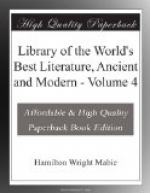to day, and multiplying petty details with convincing
logic. But in his preoccupation for mental conditions
he is apt to lose sight of the material side of life,
and the symmetry of his novels is marred by a meagreness
of physical detail and a lack of atmosphere.
Zola has laid his finger upon Stendhal’s real
weakness when he points out that “the landscape,
the climate, the time of day, the weather,.—Nature
herself, in other words,—never seems to
intervene and exert an influence on his characters”;
and he cites a passage which in point of fact admirably
illustrates his meaning, the scene from the ‘Rouge
et Noir’, where Julien endeavors to take the
hand of
Mme. de Renal, which he characterizes
as “a little mute drama of great power,”
adding in conclusion:—“Give that episode
to an author for whom the
milieu exists, and
he will make the night, with its odors, its voices,
its soft voluptuousness, play a part in the defeat
of the woman. And that author will be in the
right; his picture will be more complete.”
It is this tendency to leave nature out of consideration
which gives Stendhal’s characters a flavor of
abstraction, and caused Sainte-Beuve to declare in
disgust that they were “not human beings, but
ingeniously constructed automatons.” Yet
it is unfair to conclude with Zola, that Stendhal
was a man for whom the outside world did not exist;
he was not insensible to the beauties of nature, only
he looked upon them as a secondary consideration.
After a sympathetic description of the Rhone valley,
he had to add, “But the interest of a landscape
is insufficient; in the long run, some moral or historical
interest is indispensable.” Yet he recognized
explicitly the influence of climate and environment
upon character, and seems to have been sensible of
his own shortcomings as an author. “I abhor
material descriptions,” he confesses in ‘Souvenirs
d’Egotisme’: “the
ennui
of making them deters me from writing novels.”
Nevertheless, aside from his short ‘Chroniques’
and ‘Nouvelles,’ and the posthumous ‘Lamiel’
which he probably intended to destroy, Stendhal has
left four stories which deserve detailed consideration:
‘Armance,’ ‘Le Rouge et Le Noir,’
‘La Chartreuse de Parme,’ and the fragmentary
novel ‘Lucien Leuwen.’
As has been justly pointed out by Stendhal’s
sympathetic biographer, Edouard Rod, the heroes of
the four books are essentially of one type, and all
more or less faithful copies of himself; having in
common a need of activity, a thirst for love, a keen
sensibility, and an unbounded admiration for Napoleon—and
differing only by reason of the several milieus
in which he has placed them. The first of these,
‘Armance,’ appeared in 1827. The
hero, Octave, is an aristocrat, son of the Marquis
de Malivert, who “was very rich before the Revolution,
and when he returned to Paris in 1814, thought himself
beggared on an income of twenty or thirty thousand.”
Octave is the most exaggerated of all Stendhal’s




